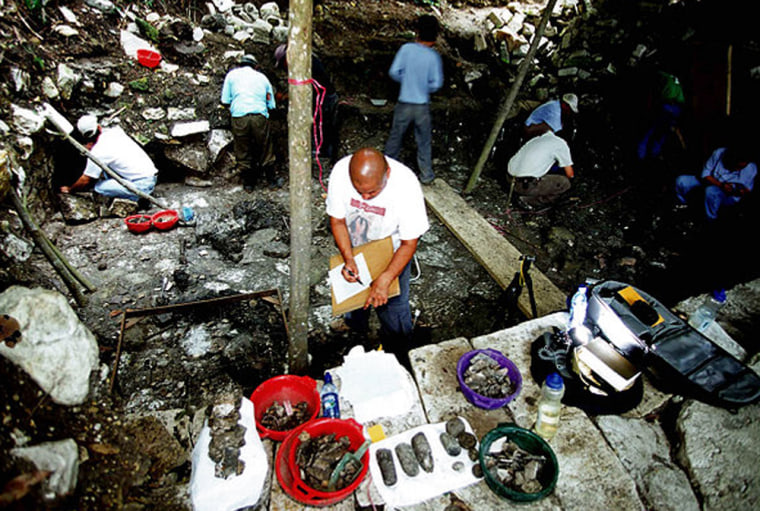Whoever they were, the invaders made short work of the enormous palace in the Mayan lowlands, ignoring half-built ramparts to corral nearly three dozen members of the royal household, systematically murder them with spears and axes, then dismember the corpses and dump the pieces into a ceremonial cistern.
Then the killers left, never to return, according to new research being reported today. Cancuen, a thriving trade hub at the headwaters of the Rio Pasion, was reclaimed by the jungle. The ritual massacre of its leaders around A.D. 800 is perhaps a key puzzle piece in the decline and ultimate collapse of Mayan civilization in what is now Central America.
"We're looking at it as an ancient war crime," said Vanderbilt University archaeologist Arthur Demarest, co-leader of a U.S.-Guatemalan excavation team. "We know who was killed, and we've proved they were assassinated. The question is: Who did it, and why?"
To help find out, Demarest enlisted the Forensic Anthropological Foundation of Guatemala, experts in the archaeology of mass murder.
But the answer to this 1,200-year-old mystery may still prove elusive. "This is one event in one place," said Robert J. Sharer of the University of Pennsylvania. "This is like finding a burned palace at a single site in Spain and trying to deduce the fall of the Roman Empire. It can't be done."
Still, Demarest suggested, Cancuen is "an early falling domino" in a century-long Mayan decline blamed by scholars on combinations of war, drought, sickness, hurricanes and ecological collapse. "Unfortunately," Demarest added, "it gets more complicated the more you know about it."
Five years of excavation
Demarest — supported by the Guatemalan government, the National Geographic Society, the Foundation for the Advancement of Mesoamerican Studies and other organizations — first excavated Cancuen in 2000.
The team found a commercial complex spread over several square miles of the Peten wilderness, about 120 miles north of Guatemala City. It was a Mayan "classic" site, dated between A.D. 300 and 900.
Cancuen's centerpiece was a three-story, 200-room palace with 11 courtyards, covering an area the size of six football fields. Located just below the central highlands, the city apparently served as a commercial center, moving raw materials from the highlands — jade for jewelry, obsidian for weapons, pyrite for mirrors — to the city-states of the Caribbean jungle.
By analyzing inscriptions, Demarest and his team determined that in the 8th century, Cancuen was enjoying a "golden age" of power and influence, guided by King Taj Chan Ahk, a Machiavellian dealmaker who ruled for nearly 40 years until his death in A.D. 795.
Taj Chan Ahk built much of the palace complex, then left his son Kan Maax to finish the job. "Kan Maax, trying to build the palace and fill his father's shoes, had a tragic time," Demarest said.
Well-preserved bones
Archaeologists discovered the mass grave while excavating a 90-square-yard ceremonial cistern next to the palace's main staircase. An underground spring had filled the pool with mud, leaving the bones well preserved.
"There are at least 31 people," said Jose Suasnavar, the Forensic Foundation's technical director. "They have been struck with spears and axes, many in the head. Many bones are fractured, but not pulled apart. That's why we think they were killed nearby."
Half-built palisades apparently failed to deter the invaders, and about 80 yards from the cistern Demarest's team found what he suggested were the skeletons of Kan Maax and his wife, buried in shallow graves. Finally, north of the main palace near a riverside pier, the team found 12 more corpses.
"We haven't looked at those," Suasnavar said. "But you would think that they'd put the armed men to guard the port." The corpses in the cistern included men, women, children and even two pregnant women, he said. "It looks like an extended family, but we won't know until DNA testing is finished."
